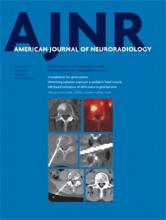Abstract
BACKGROUND AND PURPOSE: We adopted an imaging algorithm in 2011 in which extradural fluid on spinal MR imaging directs dynamic CT myelography. We assessed algorithm compliance and its effectiveness in reducing repeat or unnecessary dynamic CT myelograms.
MATERIALS AND METHODS: CT myelograms for CSF leaks from January 2011 to September 2014 were reviewed. Patients with iatrogenic leaks, traumatic brachial plexus injuries, or prior CT myelography within 2 years were excluded. Completion and results of spinal MR imaging, CT myelographic technique, and the need for repeat CT myelography or unnecessary dynamic CT myelograms were recorded.
RESULTS: The algorithm was followed in 102 (79%) of 129 patients. No extradural fluid was detected in 75 (74%), of whom 70 (93%) had no leak, 4 (5%) had a slow leak, and 1 (1%) had a fast leak. Extradural fluid was detected in 27 (26%): 24 (89%) fast leaks, 1 (4%) slow leak, and 2 (7%) with no leaks. When the algorithm was followed, 1 (1%) required repeat CT myelography and 3 (3%) had unnecessary dynamic CT myelograms. The algorithm was breached in 27 (21%) cases, including no pre-CT myelogram MR imaging in 11 (41%), performing conventional CT myelography when extradural fluid was present in 13 (48%), and performing dynamic CT myelography when extradural fluid was absent in 3 (11%). Algorithm breaches resulted in 4 (15%) repeat CT myelograms and 3 (12%) unnecessary dynamic CT myelograms, both higher than with algorithm compliance.
CONCLUSIONS: Using spinal MR imaging to direct CT myelography resulted in significant reduction in repeat CT myelograms to localize fast leaks with minimal unnecessary dynamic CT myelograms.
ABBREVIATION:
- CTM
- CT myelogram
- © 2016 by American Journal of Neuroradiology











